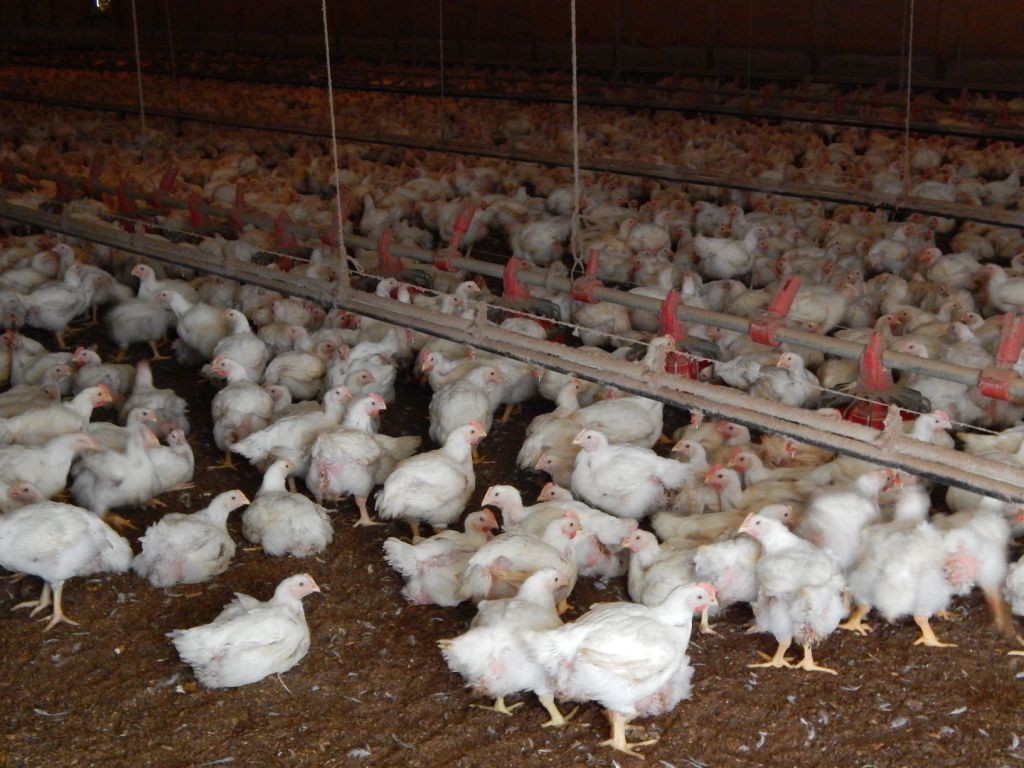Spotlight on agriculture in the Suwannee Valley
Published 9:00 am Thursday, August 13, 2015

- Broiler chickens like the ones pictured can be raised to slaughter-weight in less than 45 days.
In today’s modern world where food can be bought with relative ease, we tend to forget about who grew the veggies or raised the cow behind the beef that appears on our dinner plate. Ever since the industrial revolution of the 1800s, fewer and fewer farmers could produce higher and higher yields and we could rely on a larger industry to provide food for us. Despite the growth in state-of-the-art technology and agricultural innovations, farmers and their lifestyles are often thought of as archaic in America’s more urban areas. But everyone still relies on farmers and their land for food and that’s a fact that simply won’t change.
In rural parts of America like the Suwannee Valley, agriculture is not so easily forgotten as it is in big cities. Agriculture is what helps drive our economy and define our culture; just drive down any country road in the Suwannee Valley and you are sure to pass a farm of some sort. Acres upon acres of waving cornstalks, green peanut plants or plump watermelons are not an uncommon sight around these parts, and neither are pastures full of munching cows or long rows of chicken houses. You’ve probably seen plenty of locally grown veggies at a farmers market or roadside stand, or your children or yourself might have been involved in FFA or 4-H growing up. Even when taking food out of consideration, the influence of agriculture is all around us in one form or another.
Trending
Suwannee Valley
So, what does the typical farmer look like in the Suwannee Valley? According to the latest USDA Agricultural Census from 2012, he is a 60-year-old white man who operates a chicken, dairy or peanut farm. This operation is probably diversified, meaning the farmer invests in different crops and livestock so he doesn’t put all his eggs in one basket, so to speak. The operation is very likely owned by him or his family and not a corporation as almost 98 percent of all farms are family-owned, according to the census.
The average Suwannee Valley farm makes about $262,015 in sales each year, but after hefty production and operation costs, the farm will bring in an annual income of about $35,705, according to the census.
Government subsidies will save farmers an average of $7,974 each year, but that number doesn’t go very far to combat the ever-changing commodity prices in America. For example, the final sale price of milk depends on the price of grains to feed the cattle, which depends on the price of oil to fuel grain transport. A farmer’s income is heavily dependent on things he or she can’t control such as oil prices, the weather, industry and market regulations, or product popularity. In part, to offset this unpredictability, there’s about a 50/50 chance the average farmer has a second source of income besides his farm. This could be Social Security or retirement savings, a non-agricultural job, or a second, separate agricultural operation.
Fifty years ago the agricultural industry in our region was very different from today. Tobacco was king, but sales across the U.S. have greatly declined since then, according to the Centers for Disease Control. This decline can be attributed to increased tobacco use prevention efforts, anti-smoking legislation and increased taxes on cigarettes, among other factors. In Florida alone, tobacco farms dropped from over 3,000 farms producing nearly 27 million pounds of tobacco in 1964 to just 10 farms yielding almost 800,000 pounds in 2012. There are two reported tobacco farms each in Suwannee and Lafayette counties today.
Cotton, another former agricultural frontrunner, has also declined in sales over the last half century. Suwannee County Extension Agent Elena Toro said there are no cotton farmers in Suwannee County this year, something that’s not surprising given the drop in cotton’s sale price. Last year, however, there were 3,000 acres of cotton growing in Suwannee County. The amount of cotton production, like most if not all agricultural products, depends greatly on outside factors.
Trending
Suwannee County
Suwannee County is hands down Florida’s poultry capital in the overall agricultural sector. In 2012, local poultry farmers sold almost 39 million broilers, accounting for two-thirds of all of Florida’s broiler sales. Poultry and egg sales reached $144,744,000 in 2012 while inventory for broilers and other meat-type chickens reached nearly seven million, or almost 12 percent of Florida’s total broiler inventory. Out of the county’s 1,266 farms, 700 are primarily centered on livestock production.
Suwannee’s success largely stems from the United States’ largest chicken producer, Pilgrim’s, setting up shop in the county after their 2006 buyout of a former major producer, Gold Kist.
“There wouldn’t be any chicken production in Suwannee County without Gold Kist and there won’t be any chicken production in Suwannee County if Pilgrim’s pulls out,” said Charles Edwards, a local award-winning chicken farmer and a Pilgrim’s Producer of the Year.
Edwards’ farm has 14 chicken houses holding almost 400,000 standard white broilers with the stray off-colored chicken, which Edwards says catchers won’t touch because they are considered unlucky. Modern day chicken houses like Edwards’ are fully automated to dispense food and water and regulate temperatures, raising the chicks to slaughter-weight over about 45 days with minimal human intervention.
“Electricity is our biggest issue; we could lose chickens if it goes out and the houses get too hot or too cold,” Edwards said.
Agriculture in our area has flourished in spite of a less-than-friendly, non-agricultural environment, Edwards believes. He would like to see the county government do more to promote agricultural incentives because if the industry dies, so does a substantial part of the tax base, he said. Edwards said some farmers are struggling because of things like extra electric fees and regulations.
Edwards’ family has been farming since 1961, and, like many other family farmers, Edwards took the operational reins from his father when he retired. Although, according to Edwards, farmers never really retire.
“It’s a way of life,” he remarked. “It’s enjoyable to see things grow.”
This is a mindset echoed by many farmers, like Raymond Fletcher in Southern Suwannee County, whose family was recently named Farm Family of the Year. His fourth-generation farm on 700 acres holds over 92,000 chickens, 140 head of cattle, corn, peanuts, pine timber, and grass or hay. His fields are a mixture of irrigated and dry land, “dry” meaning the crops are “working off Mother Nature,” Fletcher said. He is also trying to achieve organic certification for some of his crops, which he said is a tedious process that could result in a great payoff.
Fletcher believes agriculture has a bright outlook due to innovations in modern technology, and is content with the steady growth of his own operation over the past 18 years he’s been in charge.
“With this lifestyle, I’ve really been able to live the American dream,” Fletcher said.
Suwannee County’s other major agricultural products include hay with over 25,000 acres dedicated to the forage crop, the highest acreage in the state. In 2014, the county produced just shy of 50 million pounds of peanuts, according to USDA findings. According to the most recent USDA data from January 2015, Suwannee also ranks as one of Florida’s top 10 cow counties with 53,000 head of cattle and calves.
The county’s largest cow-related operation per head of cattle is Shenandoah Dairy, a 2,600-acre business owned by the Henderson family since 1987. Although the dairy is listed as a corporation for business purposes, it started out as and remains a family operation, Ed Henderson stated. The dairy has grown from 100 to 3,200 milk cows, producing upwards of 86,400,000 pounds or over 10 million gallons of milk annually.
In order to make this large company run smoothly, it’s mandatory that Shenandoah’s 90 employees and the Hendersons have a “must-love-cows” attitude. Ed explained that the cow barns are more like “Cow Hiltons” where the milk cows get “everything except a mint on their pillow.” They have fresh food and water, cool temperatures and fluffed sand beds when they return from the milking parlor, where individual monitors track how much each cow produces and sends out alerts if something seems off with a cow’s production or health.
A new addition to Shenandoah and somewhat of an experiment is an open-air calf barn where calves are grouped in large pens with a milk “pipeline” for meals. Previously, calves were placed in separate pens and workers could track how much milk each one was getting. Now, it’s a bit more difficult to keep track of their consumption, but they could stand to grow faster with the open access to the pipeline.
Farmers and producers are no strangers to balancing acts like these, but Ed said he enjoys the challenges.
“The ag industry provides a very valuable and prized lifestyle,” he said. “You get a sense of family and pride, and we place a high value on being good stewards of the land and animals.”
When considering the diversity of Suwannee County farms, about one in five principal farm operators are women although many farms are operated by a husband and wife team. There is a growing number of Hispanics managing operations in the county, although white farmers represent the majority of operators at large.
Overall, agricultural and related industries generate nearly half of all jobs in Suwannee County and contribute 42 percent of the county’s gross regional product with $459 million in revenues. The county is a leader in Florida for agricultural yields and revenues, but it’s by no means easy to maintain that leadership.
According to Suwannee County Extension Agent Elena Toro, the fluctuating global market, pressure from regulatory and environmental agencies, a dwindling labor force and changing technology are just a few of the challenges modern producers face. Some farmers choose to retire early or get out of produce, which is relatively harder to reap profits from than other agricultural sectors, according to Toro.
“Farmers are very independent by nature and many of them are not fans of doing all of this regulatory paperwork,” Toro explained. “One of the questions we’re asking is ‘How can they continue to make it?’ With family farms, which most farms are, everyone in the family has to be involved for it to succeed, but not everyone has that nuclear family.”
One of the major issues the agricultural industry will have to contend with is the future generation of farmers. Toro said there aren’t very many young people entering into farming, and as the older generation retires it will be interesting to see who, if anyone, will take their place. To combat that, the UF/IFAS Extension and other agencies are working to promote agriculture to youth by hosting fun activities and fairs where kids are exposed to the industry.
“The disconnect between the community and those that live on a farm is huge,” Toro said. “It’s important for us to relay the message to kids that food doesn’t come from a grocery store. We have to give them experiences they will remember.”
Lafayette County
As of the last agricultural census in 2012, Lafayette County has 221 farms with an average size of 413 acres. Almost all are well-established, family-owned farms that use traditional farming practices, Lafayette County Extension Agent Chris Vann said.
“[There’s] not a lot of new farms, but younger generations are playing a more important role on the farm,” Vann said. “It would be difficult for someone to begin farming without inheriting or marrying into it, but it can be done.”
USDA data shows over a third of all jobs in Lafayette County are related to agriculture with the average principal farm operator being a white male in his 60s. Minorities that are relatively well-represented in the agricultural sector of Lafayette County include women, who make up 14 percent of principal farm operators, and Hispanics, who make up six percent of all operators.
Vann stated most of Lafayette County’s farmers are full-time, although some have “off-farm employment” or additional agricultural operations in beef or timber.
The most popular crops in the region are timber, forages or pasture and hay, peanuts (the county produced 18.6 million pounds in 2014), corn, cotton and tobacco, Vann reports. The county’s annual yield for peanuts and tobacco is higher than the state average, Vann said, making Lafayette County one of the few successful tobacco-producing regions in the country.
“Twenty-five to 50 years ago, tobacco was very important, although the acres were only around 1,000,” Vann said. “Tobacco money paid the bills. This was not only in Lafayette County, but the entire Suwannee Valley area.”
Today it is livestock, not tobacco, that holds Lafayette County’s agricultural spotlight. The county’s powerhouse is dairy, according to Vann, who said Lafayette is one of the top three dairy-producing counties in the state with over 12,800 milk cows.
Five hundred of those milk cows reside at ATR Dairy along with 400 heifers in Eastern Lafayette County. The operation has been run by UF alumni Eddie Fredriksson and Scott McAdams since 2004. Fredriksson said the most recent economic recession proved to be one of the worst periods for dairy in modern history, as changes trickled down from the banking world to affect ethanol prices and then grain prices. Despite that, Lafayette County has remained one of the most successful dairy-producing regions in America.
“We have enough dairies here that we attract the things we need,” Fredriksson said. “We’ve got the labor force, the structure and maintenance, and the livestock supplies. You can’t succeed on an island. The population also accepts dairy farms. Everyone has some connection to a dairy farm and we don’t have people with a problem with dairies in this county.”
Frediksson became involved in the dairy business when McAdams’ father presented them with the opportunity to buy ATR Dairy. Both partners’ families were involved in agriculture and they have followed in their footsteps, but Fredriksson said it is sometimes harder for younger generations to become producers or farmers.
“Production agriculture has become an endeavor that few do any more,” he said. “Young people aren’t exposed to agriculture in an intimate way, and their interest goes elsewhere. This area is unique to that in that it has an agriculturally-driven economy.”
Fredriksson and other dairies like ATR Dairy have also met challenges in marketing their product. Milk consumption appears to reduce with each generation according to USDA findings, and Fredriksson wants people to know that milk is one of the safest and most wholesome things you can drink nowadays.
“As the beverage market becomes saturated with other things, it becomes harder and harder to get our product to the consumer,” he said.
Just like neighboring counties, Lafayette is also one of the state’s top five poultry producers with a total broiler chicken inventory of over 1.1 million.
With total agricultural sales hovering around $150 million annually, Lafayette County ranks as one of Florida’s top 20 counties for agricultural yields and revenue, Vann said.
“[It’s] very impressive for a county that is the second least populated in the state,” he remarked. “Some data indicates that over half of the economy of Lafayette County is agriculturally driven.”
Hamilton County
The average sales income for a farm operator in Hamilton County is about $155,770, according to Hamilton County Extension Agent Keith Wynn.
“We have both farmers who depend on their production practices as their sole source of income and some who have second jobs,” Wynn said.
The county’s economy is largely driven by agriculture and its related industries. Those industries generate over 65 percent of all jobs in Hamilton County and contribute 78 percent of the county’s gross regional product.
The total market value of agricultural products sold in 2012 was nearly $45.5 million, and all of this comes from 292 farms with an average size of 246 acres. According to Wynn, 98 percent of these farms are owned by families who utilize traditional farming practices like rotational or management-intensive grazing.
“Most Hamilton producers continue to use traditional agricultural practices, but in order to remain sustainable have adopted modern technology, such as precision planters, assisted-steering tractors and improved irrigation technology on center pivots,” Wynn said.
When considering demographics, African-American farmers make up 12 percent of Hamilton County’s farmer population – the highest percentage of African-American farmers in the Suwannee Valley. Almost four percent of the county’s farmers are Hispanic and the rest are predominately white. One in six Hamilton County principal farm operators are women and the average age of all operators is almost 62 years old.
Because the vast majority of Hamilton County’s farms are traditional family farms, new farms are a rare venture.
Hamilton County’s best-selling crops are peanuts, corn, soybeans, carrots and sweet potatoes, Wynn reports. Peanuts are Hamilton’s most popular crop with 2.45 million pounds sold in 2011, and the legume has remained the county’s best-seller for the last decade, surpassing the cash crop for most of North Florida in the 20th century, tobacco.
The county’s top livestock production is in cattle and calves, according to Wynn. USDA data also shows some Hamilton County farms have particularly high inventories of quail and chukar partridges. Hamilton is actually in the top 100 counties in America for peanut and carrot production, and for having high inventories of quail and chukar.
Less popular but still significant, Hamilton County products include broilers and other meat-type chickens; grains, oilseeds, dry beans and dry peas; and hogs and pigs.





